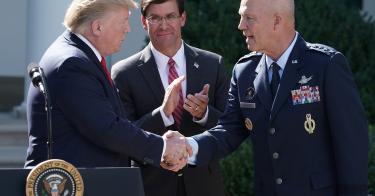At the ripe age of three months, the U.S. Space Force has already experienced the vagaries of the federal budgeting process—at least at first glance.
President Trump’s fiscal year 2020 budget requested more than $72 million to get the new service up and running. Congress wound up budgeting a bit over half that amount, $40 million.
That’s not as parsimonious as it may appear. The president’s request was to cover a full year. But Congress was three months late passing the defense budget, so the $40 million need only last nine months. So, for example, the president sought $53 million for operations and maintenance. That works out to $39.75 million for a nine-month period. Congress actually appropriated a little more than that: $40 million. No worries there.
The remaining $19 million in the president’s budget request was to cover personnel costs, but technical challenges in the military bureaucracy prevented the Space Force from directly paying those personnel. For the time being, that task and the associated funding remains with and is being paid by the Air Force. So in fact, the Space Force actually is being well funded by Congress—for now.
The challenge yet to be resolved is on the limits Congress put on the people and assets that can become part of this service.
When it authorized the Space Force in the 2020 National Defense Authorization Act, Congress limited the service to the work force, assets, and installations that could be pulled from the Air Force alone. So far, approximately 16,000 of the 27,000 military and civilian space personnel, working on five major installations, have been assigned to support the new service.
Methodically expanding the Space Force to include the remaining 11,000 Air Force military and civilian space professionals will likely take at least one more year to complete. But that will only get us to a 60% solution.
In order to remedy the dysfunctional oversight and command-and-control issues the Space Force initiative was intended to resolve, the new service will need to include the space assets, facilities and roughly 21,000 space professionals who remain in the Army and Navy.
Unfortunately, there are several impediments to making that happen. First, having labored extensively to produce the landmark legislation that created the Space Force, Congress often suffers from “success fatigue,” and it may not see the inclusion of the other services as a challenge worth taking on. That would seriously inhibit the new service’s ability to make continued progress.
Moreover, if history is any guide, you can certainly expect the Navy and Army to push back on the demand that they give up their space professionals. They may attempt to make the argument that only members of their own service can truly provide integrated space support. However, the examples of Air Force forward-air controllers supporting the Army, and Navy corpsmen supporting Marines would seem to undermine that argument.
And then there’s the Black Swan. The immense emotional and fiscal weight of the ongoing pandemic crisis will continue to fully consume the administration, Congress and the armed services for the months ahead.
Collectively, these arguments may serve to diffuse the light that has been on the Space Force, but Congress should not waiver in its efforts to follow through. Bringing it all together is estimated to cost an additional $500 million annually, but the enhancements those moves will bring to the Defense Department will be significant.
To that end, the 2021 National Defense Authorization Act should mandate that the Defense Department move the space professionals from all the services into the Space Force by the end of Fiscal 2025. Going big will eliminate unnecessary redundancies, streamline space oversight and command and control, and surely enhance combat capability.
This piece originally appeared in The Washington Times



